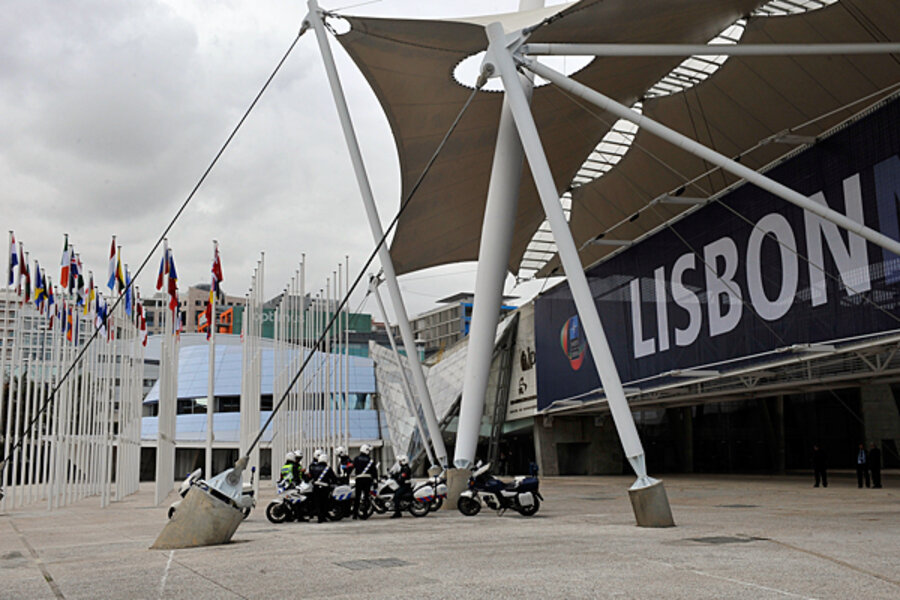NATO's Lisbon meeting agenda: Afghan withdrawal and emerging threats
Loading...
| Lisbon
NATO leaders meet here Friday to define a new mission statement, a task the North Atlantic Treaty Organization has not undertaken since before the 9/11 terrorist attacks. In addition to traditional security concerns, the agenda will cover the advent of so-called cyber terrorism, and the emergence of new threats to alliance members such as ballistic missiles in Iran.
For US Ambassador to NATO Ivo Daalder, the goal of the NATO summit and the new “strategic concept” it is expected to deliver is nothing short of a “revitalization of NATO for the 21st century” by endowing the 28-nation alliance with “a new vision, new capabilities, and a new organization.”
But at the same time NATO leaders, including President Barack Obama, will grapple with Afghanistan and the problem of how and when to end the Alliance’s nearly decade-old military campaign there.
A pre-summit spat in Kabul this week between Afghan President Hamid Karzai and NATO’s supreme commander in Afghanistan, Gen. David Petraeus, over a recent uptick in Special Operations’ night raids of Afghan homes has renewed the perennial frustration at working with Mr. Karzai and will punctuate the deliberations.
Both Karzai and General Petraeus will be on hand in Lisbon to brief the leaders of the 47 countries taking part in the international campaign in Afghanistan. In addition to the 28 NATO members, 19 non-NATO countries are also involved.
Karzai and Petraeus met in Kabul Wednesday to iron out differences before the summit, but NATO’s top civilian representative in Afghanistan, Mark Sedwill, said Wednesday that the two officials have “different perspectives” on the use of night raids, among other issues. Karzai said Sunday in a Washington Post interview that the raids by American forces are alienating civilians and he asked that American military visibility be scaled back. Petraeus told Karzai that the raids, which are now led by Afghan forces, have been instrumental in recent successes against the Taliban, according to NATO officials.
Speech preview
NATO sources who asked not to be identified say Karzai and Petraeus will present a sense of common purpose following their Kabul meeting, but they also say Karzai agreed to have his speech to summit leaders previewed by NATO officials, a point that conveys the lingering anxiousness over the Afghan leader’s penchant for tossing bombshells.
Still, Topic A on the alliance’s Afghanistan agenda will be the timetable for a drawdown of military forces and a transition to a civilian-led engagement in the country. Karzai and NATO members continue to cite the end of 2014 as the date by which security operations will have shifted to Afghan forces. Canada’s announcement this week that it will end its combat mission next year and replace that with nearly 1,000 military trainers, plus civilian development and humanitarian specialists, is considered by many, including at the White House, a model for NATO’s long-term involvement in Afghanistan.
But at the same time doubt is developing over whether the 2014 goal will be met. All eyes will be on President Obama when the leaders discuss Afghanistan on Saturday for hints of any wavering in US intentions. Administration officials say Obama is sticking by his plan to begin a “conditions-based” drawdown of US combat forces in July 2011, but some officials (in particular at the Pentagon) now expect the drawdown to be light – some say symbolic – at the outset.
Suggestions that the 2014 date is not set in stone are also surfacing. Mr. Sedwill, NATO's Afghanistan representative, said Wednesday that while “the balance of the mission would have shifted” by the end of 2014, some areas of Afghanistan may still require a NATO military presence into 2015.
The Afghanistan war may be a separate item on the summit’s agenda, but the NATO mission there will heavily influence the discussion of the alliance’s new “strategic concept” that leaders are set to approve.
What's the concept?
NATO Secretary General Anders Fogh Rasmussen says Afghanistan has taught both “how to” and “how not to” lessons for future alliance interventions. For one thing, he says that the training of local security forces must be an integral part of any operation from the beginning. In a speech last month, Mr. Rasmussen noted that NATO’s training mission in Afghanistan only got going in 2008. “Waiting that long was a mistake,” he said, suggesting that it put off when “we can go home.”
Another lesson of Afghanistan, Rasmussen says, is that – unlike the conventional military conflict NATO was envisioned to deter, or eventually fight – the 21st century’s threats will rarely if ever be addressed by military intervention alone. That will mean more focus on humanitarian and civilian-led development missions in places that are at risk of harboring international terrorist threats.
Adapting a 20th century alliance to 21st century threats will mean a stronger focus on emerging threats – like cyber attacks on the alliance members’ financial system, or defending against the growing threat of ballistic missiles – and less dependence on traditional military structures. NATO leaders are expected to enshrine these concepts in their new vision, for example by approving the deployment of a missile defense system to protect member countries.
The new concept will also mean trimming back a bureaucracy that has expanded to 14 agencies and a command structure with more than 13,000 employees and numerous headquarters. Following leaders’ edicts for a more streamlined and efficient organization with better coordination of members’ capabilities, NATO officials are proposing a cut of nearly 4,000 command structure employees and the number of agencies down to three.
In the interest of getting the over-all concept approved, however, NATO is only offering a “generic model” for its own bureaucratic reform and is not yet specifying which headquarters and which employees would be lost.
As countries like the US that are currently trying to rein in defense spending know, a likely way to kill a reform proposal is to specify who will bear the brunt of “streamlining” and cutbacks.





